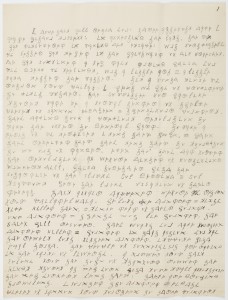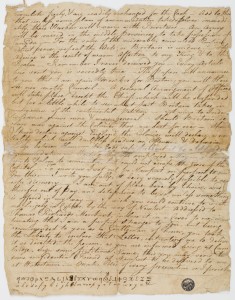 Ever since we’ve been recording information, we’ve been trying to find ways to keep it out of the wrong hands. This need often times comes to the forefront during times of war and conflict when information is at its most valuable. Codes, ciphers, even invisible ink, have been employed quite successfully and famously in the past, so it wasn’t rare to find a coded letter in our manuscript collection here at AAS. However, rare or not, when one finds a coded letter, one has to investigate!
Ever since we’ve been recording information, we’ve been trying to find ways to keep it out of the wrong hands. This need often times comes to the forefront during times of war and conflict when information is at its most valuable. Codes, ciphers, even invisible ink, have been employed quite successfully and famously in the past, so it wasn’t rare to find a coded letter in our manuscript collection here at AAS. However, rare or not, when one finds a coded letter, one has to investigate!
Perhaps lesser known than George Washington’s or Benedict Arnold’s use of code are the treasonous letters of Dr. Benjamin Church. Church, a Harvard-trained physician and close confidant of Samuel Adams, John Hancock, and Paul Revere, was appointed the first Surgeon General of the Continental Army. He even participated in the Boston Tea Party. Despite his patriotic façade, he provided General Thomas Gage with information about munitions, military plans, and equipment. It is unknown why he sold secrets to the British. Some believe it was his attempt to uphold his luxurious lifestyle when money got tight. Others think it was the influence of his British wife. Whatever the reason, he was found out, imprisoned for treason, and after serving some years in prison, was exiled to the West Indies. The ship, however, never reached her destination, and Church was never heard from again.
 One of Church’s coded letters, written from Philadelphia in 1777, was deciphered by Samuel West, a former classmate of Church’s from Harvard. Seen here is West’s transcription of the letter, with the broken code at the bottom. This letter was found within our West Family Collection (and was later moved to our US Revolution Collection). The original coded letter written by Church can be seen at the Library of Congress.
One of Church’s coded letters, written from Philadelphia in 1777, was deciphered by Samuel West, a former classmate of Church’s from Harvard. Seen here is West’s transcription of the letter, with the broken code at the bottom. This letter was found within our West Family Collection (and was later moved to our US Revolution Collection). The original coded letter written by Church can be seen at the Library of Congress.
Just out of curiosity, I passed a copy of the letter, in code, to a friend who had recently taken a cryptography class. Upon my brief and inexpert inspection, the code seemed somewhat easy to crack, but I had the translated letter right beside it, so I’m sure that increased my confidence as I guessed my way through the code. It turns out, though, I was right. The letter was completely deciphered in about one hour. Why was it so easy? Church used a simple mono-alphabetic code, assigning a single symbol to a single letter. All it takes to crack a code such as this is a quick character analysis (observing which characters appear most frequently, which characters are always next to one another, etc.) and one can quickly determine which characters represent which letters.
I wonder why, when performing such a dangerous, treasonous act, Church didn’t take better care to disguise his secrets. Why did he use such a simple code? The code surely kept the message secret from casual readers or interceptors, so perhaps those were the only readers Church was worried about. But anyone who really wanted to could easily break it. If one is to go into the business of espionage, one best use a complex code. As Church stated at the end of his letter – “Use every precaution or I perish –”. He should have heeded his own advice.
